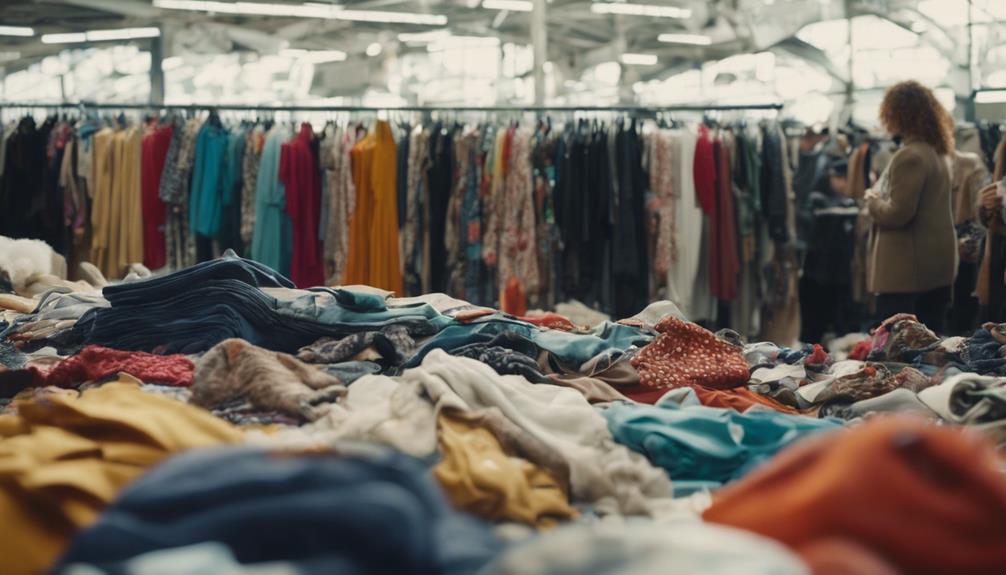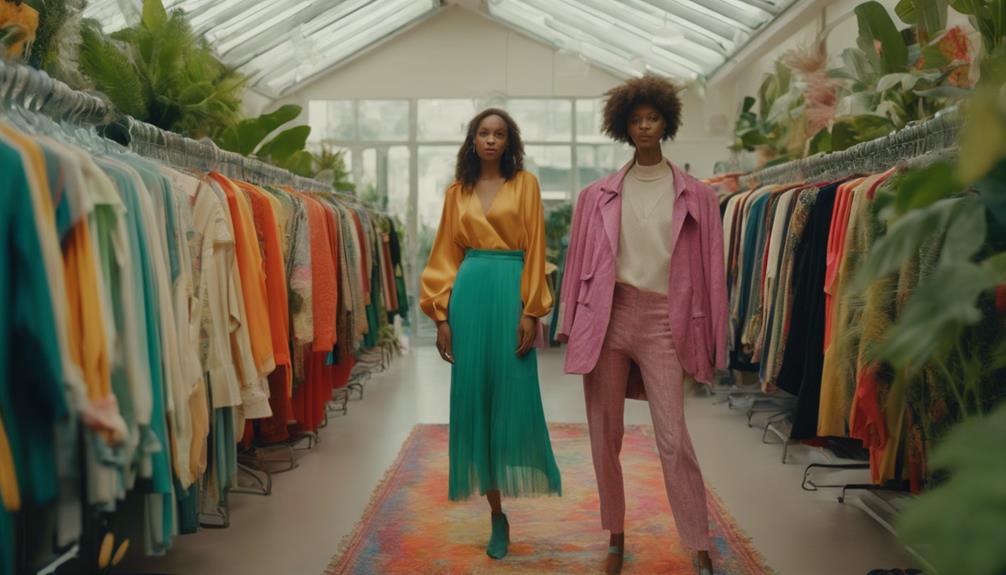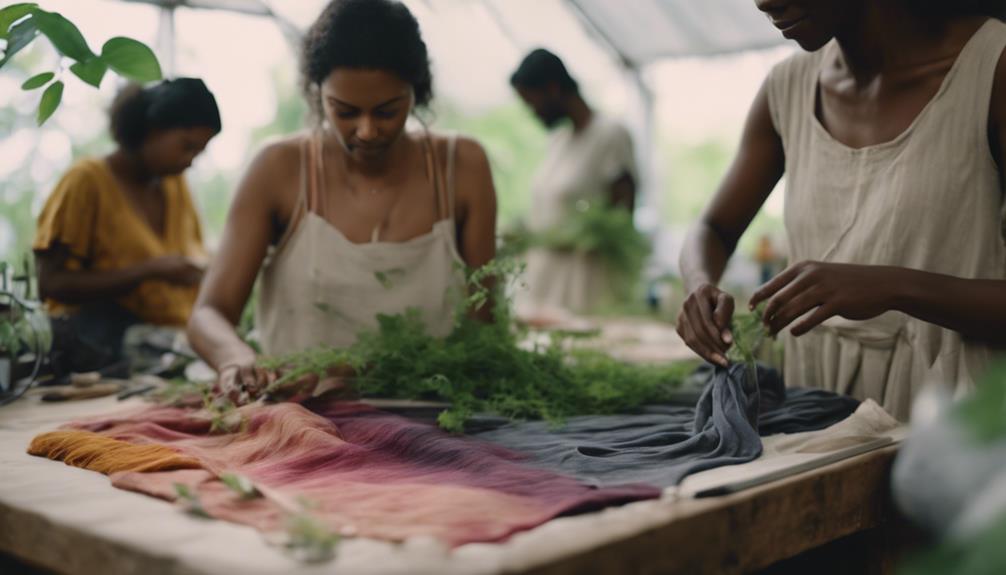Profitability in sustainable fashion can be achieved, despite facing significant challenges. Production costs are usually 25-30% higher, resulting in profit margins below 10%. Yet, there is a strong demand from consumers for ethical fashion, with 92% willing to pay extra for responsibly made items. Brands like Patagonia have proven that fostering long-term customer loyalty can drive growth, even amidst initial obstacles. While sustainable practices may deter some price-sensitive buyers, effective marketing strategies and transparency can attract eco-conscious consumers. To fully understand the dynamics and potential of this market, further insights should be explored. One of the primary challenges faced by sustainable fashion is the higher initial production costs, which may discourage some brands from transitioning. However, as awareness and demand for ethical products grow, there is an increasing opportunity for companies to capitalize on this market. By understanding the sustainable fashion cost and implementing strategies to mitigate it, such as innovative production methods or strategic partnerships, businesses can gain a competitive advantage in this evolving industry. Check out this sustainable fashion cost article for more information.
Key Takeaways
- Sustainable fashion faces higher production costs, resulting in lower profit margins compared to fast fashion, often below 10%.
- Consumer demand for ethically made products is strong, with 92% willing to pay more for sustainable options.
- Transparency in supply chains fosters brand loyalty, with 86% of consumers preferring brands that disclose product origins.
- Sustainable brands can achieve profitability through premium pricing and long-term customer loyalty, as seen with companies like Patagonia.
Understanding Sustainable Fashion Profitability
Understanding sustainable fashion profitability requires recognizing the financial challenges sustainable brands face due to higher production costs and a market that's still adjusting to their pricing.
Unlike fast fashion brands, which often enjoy profit margins exceeding 10%, sustainable brands grapple with higher expenses tied to ethical fashion practices. These brands prioritize quality and sustainability, which leads to smaller batch sizes and higher prices—think of an Able T-shirt costing $48 versus cheaper fast-fashion alternatives.
This pricing can deter price-sensitive shoppers, particularly when consumer spending habits have shifted dramatically over the decades. In 1960, the average American household spent 10% of their income on clothing, but today that number has plummeted to 3.5%.
Despite these hurdles, there's a silver lining. Investing in durable, high-quality clothing can lead to long-term savings, as sustainable brands focus on reducing the frequency of purchases.
Additionally, the growing demand for sustainable products, with 92% of Indian adults willing to pay more, indicates a promising market potential.
Ultimately, sustainable fashion profitability hinges on balancing production costs with consumer willingness to embrace ethical fashion.
The Cost of Sustainable Practices
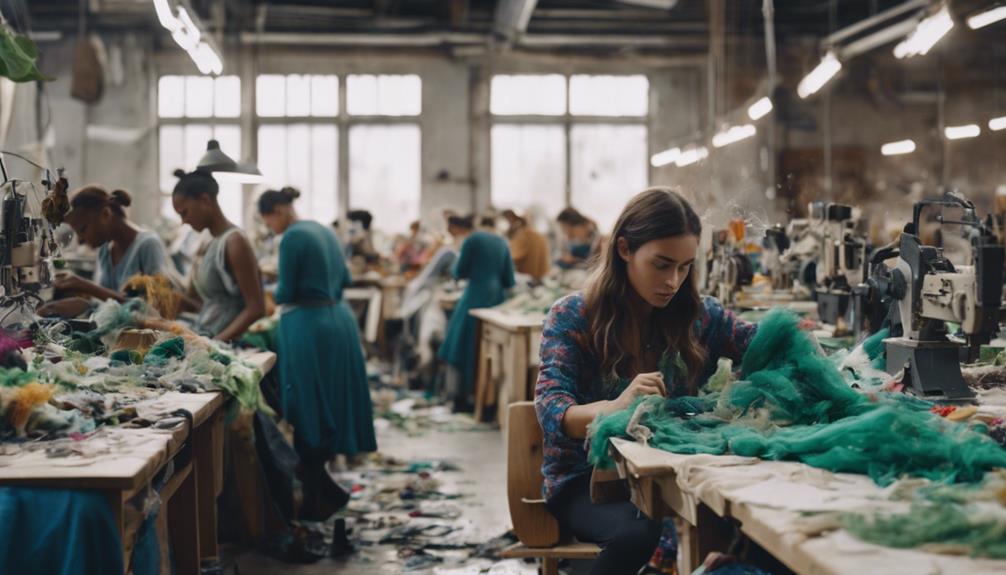
Sustainable practices often come with a price tag that reflects the commitment to ethical materials and fair labor, making them 25-30% more expensive than fast fashion options. This higher cost arises because sustainable fashion brands prioritize quality and ethical standards over quantity. They often produce garments in small batches, which limits their ability to benefit from economies of scale that fast fashion brands enjoy.
While the upfront costs might deter some shoppers, it's important to reflect on the long-term value. Durable sustainable garments often outlast their fast fashion counterparts, resulting in a lower cost-per-wear. You're not just investing in a piece of clothing; you're contributing to a system that promotes workers' fair wages and better working conditions.
However, the reality remains that only 2% of garment workers globally earn a living wage, which puts immense pressure on ethical brands. They endeavor to balance their commitment to fair wages with the financial sustainability of their operations.
As a result, the cost of sustainable practices is a reflection of the values that these brands uphold, and that can make all the difference for conscious consumers like you.
Consumer Demand for Ethical Fashion

Growing awareness of ethical practices is driving consumers to seek out fashion that aligns with their values, making ethical fashion more desirable than ever. With a significant portion of consumers now willing to pay more for ethically made products, the landscape of fashion is changing rapidly. Here's a breakdown of current trends in consumer demand:
| Factor | Percentage | Consumer Impact |
|---|---|---|
| Willingness to pay more | 92% | High demand for sustainability |
| Clothing spend (1960) | 10% | Shift in consumer habits |
| Clothing spend (Today) | 3.5% | Room for ethical growth |
| Preference for quality | High | Increased return rates |
Despite the perception that ethical brands are too expensive, awareness of the environmental impact of fast fashion is prompting a shift in expectations. Consumers are increasingly prioritizing quality and fit, which ethical brands emphasize. This evolving consumer demand reflects a desire for thoughtful purchasing decisions, indicating that ethical fashion isn't just a trend—it's becoming a staple. By aligning your choices with these values, you contribute to a more sustainable future in fashion.
Impact of Supply Chain Transparency

How does supply chain transparency influence consumer trust and brand loyalty in the fashion industry? It plays a crucial role. When brands openly share details about their supply chains, you're likely to feel more confident in your purchases. In fact, 86% of consumers, like you, would be more loyal to a brand that practices transparency.
With 66% of shoppers willing to pay a premium for ethical sourcing, transparency can greatly enhance a brand's profitability.
Moreover, the lack of transparency in fast fashion often leads to exploitative labor practices. Only 2% of garment workers earn a living wage globally, which raises serious ethical concerns. As a consumer, you probably want to support brands that prioritize fair treatment for workers. A staggering 73% of you want brands to disclose the origin of their products, emphasizing the demand for clearer supply chains.
Implementing supply chain transparency doesn't just help you feel good about your purchases; it can also lead to cost savings and efficiency for brands. By embracing sustainability and accountability, brands can improve their reputation and reduce operational risks, ultimately benefiting both you and the garment workers involved.
Challenges Facing Sustainable Brands

While transparency builds trust and loyalty, sustainable brands face significant challenges that impact their profitability in a market dominated by fast fashion. One major hurdle is the higher production costs associated with ethical practices. This often results in retail prices that deter price-sensitive consumers who are used to the low costs of fast fashion.
Moreover, the fashion industry's systemic overproduction, with approximately 87% of the 150 billion garments produced annually ending up in landfills, complicates the situation for sustainable brands. They struggle with limited access to sustainable fabric options, which can hinder their ability to scale effectively.
As you navigate this landscape, you'll find that sustainable brands need to invest in education and awareness campaigns to shift consumer perceptions that low prices equate to higher value. Competing against fast fashion giants that capitalize on economies of scale makes it difficult for you to achieve similar profit margins while adhering to ethical production standards.
In this challenging environment, sustainable brands must innovate and adapt to overcome these barriers, balancing their commitment to ethical practices with the realities of market demands.
Market Trends in Fashion Sustainability

The sustainable fashion market is witnessing a considerable shift as consumers increasingly demand eco-friendly products that align with their values. This trend is pushing brands to adapt, and it's showing promise for profitability. With a projected compound annual growth rate (CAGR) of 9.7% from 2021 to 2028, the market is set to expand considerably.
Here are three key trends driving this change:
- Consumer Awareness: More shoppers are understanding the environmental impact of fast fashion, leading to a rise in secondhand shopping and clothing mending.
- Ethical Practices: Brands prioritizing sustainability, such as Unilever's Sustainable Living Brands, are outperforming traditional counterparts, growing 69% faster in 2018.
- Waste Reduction: The fashion industry's staggering statistic of 150 billion garments produced annually, with 87% ending up in landfills, urges brands to implement sustainable practices to improve profitability.
While sustainable fashion often means higher prices reflecting fair wages, including minimum wage considerations, the demand for ethical practices suggests that consumers are willing to invest in products that resonate with their values.
The Role of Marketing in Profitability
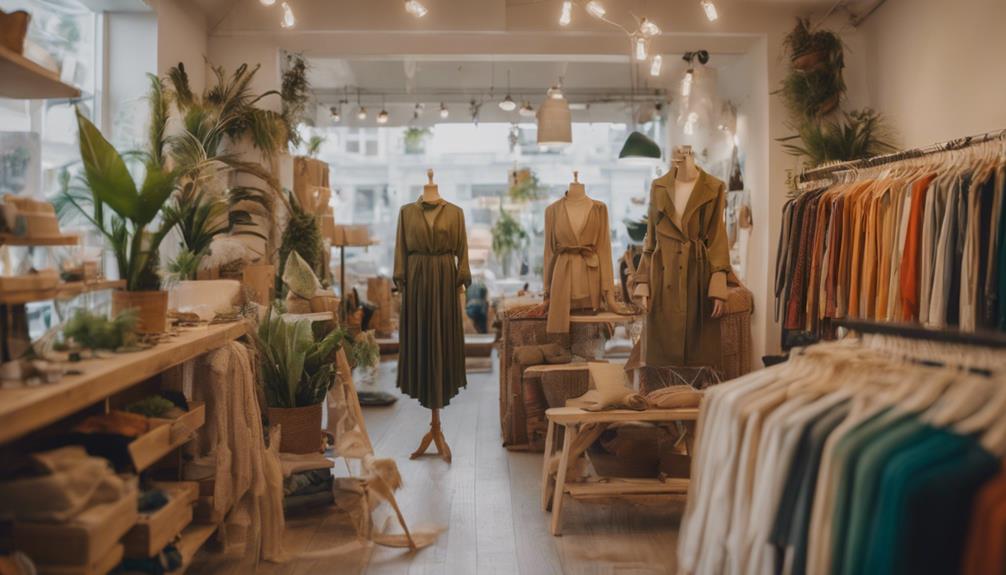
Marketing plays an essential role in driving profitability for sustainable fashion brands by effectively communicating their eco-friendly values to conscious consumers. As you navigate the market, you'll notice that brands prioritizing sustainability in their marketing strategies can draw in eco-conscious shoppers. For instance, Unilever's Sustainable Living Brands grew 69% faster than non-sustainable ones, proving the power of sustainability-focused marketing.
With 92% of Indian adults willing to pay more for sustainable products, there's a clear demand for eco-friendly fashion. Effective marketing not only strengthens brand loyalty but also shields you from backlash over superficial sustainability claims. Genuine commitment to ethical practices, when communicated transparently, builds trust and credibility—two crucial elements for profitability.
Take note of brands like Everlane, which showcase radical pricing transparency, enhancing consumer confidence in their sustainability claims. While production costs may be higher, sustainable brands can still thrive. By focusing on quality and durability, you align with consumers' desires for lasting value over fast fashion's disposability.
In this way, strategic marketing becomes a cornerstone for achieving both sustainability and profitability in the fashion industry.
Case Studies of Successful Brands

You'll find that several brands have turned sustainability into a profitable business model.
By aligning their practices with market demand for ethical products, these companies haven't only boosted their sales but also attracted loyal customers.
Let's explore how their financial success showcases the viability of sustainable fashion.
Financial Viability of Sustainability
Brands like Patagonia and Everlane show that prioritizing sustainability not only aligns with ethical values but also leads to impressive financial success. Their journeys illustrate the financial viability of sustainable fashion and how it can drive significant profits.
Here are three key reasons why sustainable brands thrive financially:
- Higher Profit Margins: Consumers are increasingly willing to pay a premium for ethically produced goods. For instance, 92% of Indian adults are open to spending more on sustainable products, reflecting a growing market demand.
- Rapid Growth Potential: Companies that adopt sustainable practices can achieve remarkable growth. Unilever's Sustainable Living Brands grew 69% faster than traditional brands in 2018, showcasing the financial opportunities available for eco-conscious businesses.
- Long-term Customer Loyalty: Although ethical brands may face higher initial production costs, they often benefit from customer loyalty and reduced inventory waste. This resonates with a significant demographic of environmentally-conscious consumers, allowing for sustained profitability over time.
Market Demand for Ethics
A growing number of consumers are seeking out ethical fashion options, as demonstrated by the success stories of brands like Patagonia and Everlane that have embraced sustainability. These sustainable brands appeal to a market that increasingly values ethics in purchasing decisions. Research shows that Unilever's Sustainable Living Brands grew 69% faster than conventional brands in 2018, highlighting the growing market demand for ethics.
You'll find that ethical fashion often commands higher profit margins. While fast-fashion brands typically exceed 10% profit margins, sustainable brands cultivate loyalty through transparency and alignment with consumer values. In fact, 92% of Indian adults express a willingness to pay more for eco-friendly products, indicating a strong desire for ethical choices.
Moreover, sustainable brands like Patagonia and Everlane not only gain popularity but also enjoy long-term profitability due to heightened consumer awareness. Their success proves that when brands prioritize sustainability, they don't just meet consumer demand; they thrive in the market.
As you explore these case studies, it's clear that the shift toward ethical fashion offers a promising path for profitability while aligning with the values of conscientious consumers.
Regulatory Influence on Fashion Industry

Regulatory influence is essential in the fashion industry, as it holds companies accountable for their environmental and labor practices, driving the shift towards sustainability. Without regulatory intervention, many brands overlook their negative impacts, leading to widespread pollution and exploitation of workers. Currently, only 2% of garment workers earn a living wage globally, underscoring the need for imposed labor standards.
Here are three key areas where regulation can make a difference:
- Environmental Standards: Regulations can mandate the use of sustainable materials like organic cotton, reducing the industry's overall pollution levels.
- Labor Rights: By enforcing labor standards, regulations can guarantee fair wages and safe working conditions for garment workers, which fosters ethical production.
- Transparency and Accountability: Regulatory frameworks can require brands to disclose their environmental and labor practices, building consumer trust and encouraging responsible choices.
As the fashion industry remains a significant polluter, the urgency of regulatory measures can't be overstated. By implementing these changes, you can help create a more sustainable and ethical fashion landscape that benefits everyone involved.
Future Outlook for Sustainable Fashion

With regulatory measures pushing for greater accountability, the future outlook for sustainable fashion looks promising as consumer demand for eco-friendly products continues to rise. The global sustainable fashion market is projected to reach $8.25 billion by 2023, indicating a significant shift in consumer preferences.
You'll find that brands prioritizing sustainability often experience increased customer loyalty. For instance, Unilever's Sustainable Living Brands grew 69% faster than traditional brands in 2018, showcasing the potential profitability of ethical brands.
However, it's important to recognize that sustainable fashion isn't without its challenges. Ethical brands frequently face financial risks due to higher production costs and unsold inventory. Despite this, there's a notable willingness among consumers to pay more for sustainable products; 92% of Indian adults are ready to spend extra on eco-friendly options.
Transparency and accountability will play a vital role in shaping the future of sustainable fashion. Brands that genuinely commit to ethical practices can enhance their credibility and market share, making it a lucrative space for those willing to adapt.
Ultimately, the future for sustainable fashion looks bright, provided brands navigate the challenges effectively.
Frequently Asked Questions
What Is the Problem With Sustainable Fashion?
Sustainable fashion faces challenges like higher material costs, limited recycling capabilities, and lack of regulation. You might struggle to find affordable options, and ethical brands often deal with financial risks due to these issues.
Do People Really Care About Sustainable Fashion?
When it comes to sustainable fashion, you're not alone; many folks genuinely care. However, price often puts a damper on their intentions, leading to a tug-of-war between ethics and affordability for consumers like you.
Is Sustainable Fashion for the Rich?
Sustainable fashion isn't just for the rich. While prices can be higher, many consumers prioritize ethical choices. With growing awareness, more affordable sustainable options are emerging, making it accessible for everyone who values sustainability.
What Is the Paradox of Sustainable Fashion?
They say, "You get what you pay for." The paradox of sustainable fashion is that while you invest more upfront for ethical practices, the long-term benefits often outweigh the initial costs, challenging your perceptions of value.
Conclusion
In the end, sustainable fashion can be profitable, but it requires commitment and strategy.
Take the story of Veja, a sneaker brand that prioritizes ethical sourcing and transparency. Their dedication not only attracted loyal customers but also showed that doing good can lead to financial success.
As you consider your own choices, remember that supporting sustainable brands isn't just about style; it's about investing in a better future for our planet and its people.
